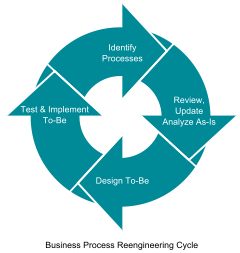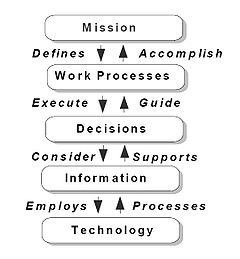


 |

|

|
|
GOLF |
|
||
Business process re-engineering is a business management strategy, originally
pioneered in the early 1990s, focusing on the analysis and design of workflows
and processes within an organization. BPR aimed to help organizations fundamentally rethink how they do
their work in order to dramatically improve customer service,
cut operational
costs, and become world-class competitors.
In the mid-1990s, as many as 60% of the Fortune 500 companies claimed to either have
initiated reengineering efforts, or to have plans to do so.
BPR seeks to help companies radically
restructure their organizations by focusing on the ground-up design of their
business processes. According to Davenport (1990) a business process is a set
of logically related tasks performed to achieve a defined business outcome.
Re-engineering emphasized a holistic focus on business objectives and how
processes related to them, encouraging full-scale recreation of processes
rather than iterative optimization of subprocesses.
Business process re-engineering is also known as
business process redesign, business transformation, or business process change
management.

Business Process Re-engineering (BPR) is
basically rethinking and radically redesigning an organization's existing
resources. BPR, however, is more than just business improvising; it is an
approach for redesigning the way work is done to better support the
organization's mission and reduce costs. Reengineering
starts with a high-level assessment of the organization's mission, strategic
goals, and customer needs.
Basic questions are asked, such as "Does our mission need to be redefined?
Are our strategic goals aligned with our mission? Who are our customers?"
An organization may find that it is operating on questionable assumptions,
particularly in terms of the wants and needs of its customers. Only after the
organization rethinks what it should be doing, does it go on to decide how best
to do it.
Within the framework of
this basic assessment of mission and goals, re-engineering focuses on the
organization's business processes�the steps and procedures that govern how
resources are used to create products and services that
meet the needs of particular customers or markets. As a
structured ordering of work steps across time and place, a business process can
be decomposed into specific activities, measured, modeled, and improved. It can
also be completely redesigned or eliminated altogether. Re-engineering
identifies, analyzes, and re-designs an organization's core business processes
with the aim of achieving dramatic improvements in critical performance
measures, such as cost, quality, service, and speed.[1]
Re-engineering recognizes that an organization's business
processes are usually
fragmented into sub processes and tasks that are carried out by several
specialized functional areas within the organization. Often, no one is
responsible for the overall performance of the entire process. Re-engineering
maintains that optimizing the performance of sub processes can result in some
benefits, but cannot yield dramatic improvements if the process itself is
fundamentally inefficient and outmoded. For that reason, re-engineering focuses
on re-designing the process as a whole in order to achieve the greatest
possible benefits to the organization and their customers. This drive for
realizing dramatic improvements by fundamentally re-thinking how the
organization's work should be done distinguishes re-engineering from process
improvement efforts that focus on functional or incremental improvement.
In 1990, Michael Hammer, a former professor of computer
science at the Massachusetts Institute of Technology (MIT), published the article
"Reengineering Work: Don't Automate, Obliterate" in the Harvard Business Review, in which he
claimed that the major challenge for managers is to obliterate forms of work
that do not add value, rather than using technology for automating it. This statement implicitly accused
managers of having focused on the wrong issues, namely that technology in
general, and more specifically information technology, has been used primarily
for automating existing processes rather than using it as an enabler for making
non-value adding work obsolete.
Hammer's claim was simple: Most of the work
being done does not add any value for customers, and this work should be
removed, not accelerated through automation. Instead, companies should
reconsider their inability to satisfy customer needs, and their insufficient
cost structure. Even well-established management thinkers, such as Peter Drucker and Tom Peters,
were accepting and advocating BPR as a new tool for (re-) achieving success in
a dynamic world. During the following years, a fast growing number of
publications, books as well as journal articles, were dedicated to BPR, and
many consulting firms embarked on this trend and developed BPR methods.
However, the critics were fast to claim that BPR was a way to dehumanise the
work place, increase managerial control, and to justify downsizing,
i.e. major reductions of the work force, and
a rebirth of Taylorism under a different label.
Despite this critique, reengineering was adopted
at an accelerating pace and by 1993, as many as 60% of the Fortune 500 companies claimed to either have
initiated reengineering efforts, or to have plans to do so. This trend was
fueled by the fast adoption of BPR by the consulting industry, but also by the
study Made in America, conducted by MIT, that showed how
companies in many US industries had lagged behind their foreign counterparts in
terms of competitiveness, time-to-market and productivity.
PR reached its heyday in the early 1990's when
Michael Hammer and James Champy published their best-selling book,
"Reengineering the Corporation". The authors promoted the idea that
sometimes radical redesign and reorganization of an enterprise (wiping
the slate clean) was necessary to lower costs and increase quality of service
and that information technology was the key enabler for that radical
change.

Hammer and Champy felt that the design of
workflow in most large corporations was based on assumptions about technology,
people, and organizational goals that were no longer valid. They suggested
seven principles of reengineering to streamline the work process and thereby
achieve significant levels of improvement in quality, time management, and
cost:
1. Organize around outcomes, not tasks.
2. Identify all the processes in an organization and prioritize them in order
of redesign urgency.
3. Integrate information processing work into the real work that produces the
information.
4. Treat geographically dispersed resources as though they were centralized.
5. Link parallel activities in the workflow instead of just integrating their
results.
6. Put the decision point where the work is performed, and build control into
the process.
7. Capture information once and at the source.
By the mid-1990's, BPR gained the reputation
of being a nice way of saying "downsizing." According to Hammer, lack of
sustained management commitment and leadership, unrealistic scope and
expectations and resistance to change prompted management to abandon the
concept of BPR and embrace the next new methodology, enterprise resource
planning (ERP).
RELATED GLOSSARY TERMS: business
integration, hackathon, SRI
International (SRI), cutting edge,
competitive
advantage, UX (user
experience), 96-minute rule, Silicon Valley, IT strategy
(information technology strategy), servant
leadership
